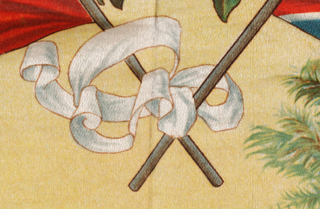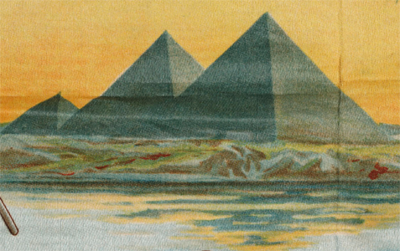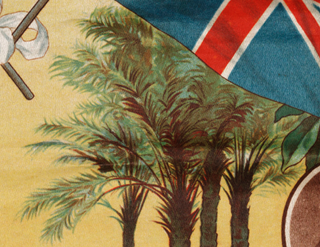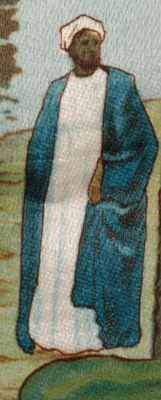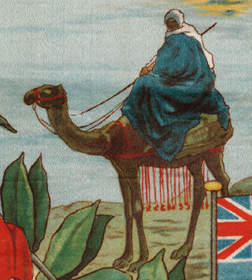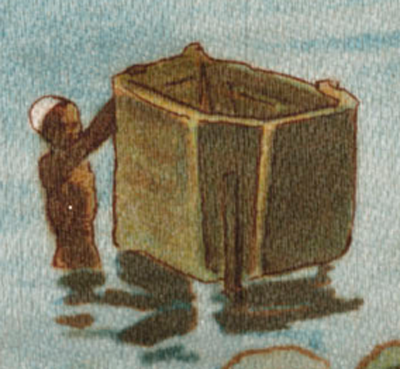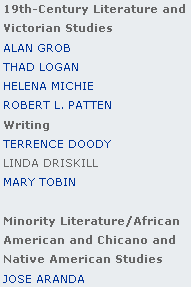The Symbols of the Souvenir of Egypt
Our goal is to determine the identity and meaning of a textile that appears
to be titled "Souvenir of Egypt", which is part of the
Travelers in the Middle East Archive
(TIMEA) Having made our way through previous modules about the Texts,
Flags and Faces in the silk, we now
come to some less concrete images which we will call the Symbols. As we try to uncover the
references behind the symbols, we will not only be attempting to identify unfamiliar visual
imagery, but also to interpret it and build an argument about its significance. The following list
will number the images and link you to the section in which each is addressed. In
order to identify some of the symbols we will venture into several disciplines,
including English and Art History, have conversations with experts we have not yet
met, and broaden our perspectives and abilities as researchers in the process.
Where to begin? Finding help with researching unfamiliar topics.
There
are many occasions in the research process in which we pause, contemplate our
options and decide that we have absolutely no idea where to begin. Finding ourselves
in areas that are completely foreign to us is one of the clearest signs that we are
learning something. It is important to push yourself to innovate and create new
options for yourself, but it is also important to know when to seek outside advice.
There are many ways to do this; we will highlight a few.
Ask your advisor for suggestions
If you find yourself stuck or don't know how to
start a research project, your advisor, mentor or instructor can probably help. When outside advice was sought for the
identification of the symbols in this project that is where we began. Chances are
you will be given the names of professors or authors of books on the subject. Bring
a note pad and take everything down.
Visit the reference desk in the library
Often, the best place to
inquire about resources for your project is the reference desk in the library of
your university. Libraries hire specialists in particular disciplines who enjoy assisting with
research projects. Visit your library's home page to find a listing of staff by subject area.
At Fondren Library, for instance, we find this listing under Departments>Reference > Librarians
Listed by Subject. We find the name of librarians focusing on Art History and English.
Let's send an email explaining our conundrum and ask for advice.
Locating a Faculty member with a background in the subject you are
researching
Interestingly, we can actually browse among the faculty members at
our universities. Nearly all of the faculty members will
have office hours when they make themselves available to students. Let's
have a look at what Rice University has to offer us for our research; feel free to
apply this technique to the web site of your own university.
We want to determine what faculty members in different departments might be
able to help us with our project. From the Rice homepage, select the
undergraduates option under the Gateways for... heading, then select the "Academics" pulldown
menu and click on departments.
You will find a list of all the departments at the university. Each department typically
includes a list of all of its faculty members and their areas of expertise. For instance,
under "Faculty" on the English department home page we find faculty divided by specialty, such
as Nineteenth Century Literature:
Apart from this helpful information, we can also find office location, hours,
telephone and email address, publications and links to the classes this instructor
has taught and will teach in the future. This is plenty of information to narrow
down our search for an expert.
The Protocol of Contacting Experts
When contacting professors to ask
them for help it is important to remember a few points of protocol:
First, professors are busy people. It would be
inconsiderate to simply drop in on them unannounced. Make sure you contact them by
telephone or email to request a few minutes of assistance.
Second, give some thought to what it is you want to know. Then put
some time into trying to figure it out for yourself. If it is obvious to the person
you are requesting assistance from that you have made no attempt to solve the riddle
yourself, he or she may not be as enthusiastic to help you as they might if you seemed to
have given the issue some serious thought.
Third, you will probably be guided in a direction, rather than
handed an answer. This is the nature of the teacher-student relationship. Even if
the person you ask for help is not your teacher, the fact that you are asking them
to advise you on a research issue places them in the position of instructor.
Remember, you are learning how to do research, not how to panhandle for information.
Fourth, by seeking the assistance of a professional you are also
entering into a professional relationship with them, so all of the protocols of
the professional relationship apply here. We would suggest sticking as close to a
formal address as you can without going overboard. Beginning one's professional
relationships on the highest level of mutual respect is the best way to insure the
success of your projects.
Our exchange with the experts
We selected a handful of experts in a
variety of fields (using the methods listed above)
and sent them all the same email, letting them know it was also sent to others and
requesting their assistance with the deciphering of the symbols we are about to
examine. We received a reply from everyone we contacted and were graced with some
very good suggestions. Here are some of them.
“I believe that printed fabric souvenirs, especially silk, became popular
near the end of c 19, in part because they were easy to carry.”
“The lower part seems quite interesting, all the orientalist visual
tropes for Egypt: the 3 pyramids of Giza, the Nile, the “fellah” (peasants), the
palm trees, the camel – it’s all there. Compositionally, this reminds me of the old
Ottoman “genealogical” portrait trees. You might want to look at The Sultan’s
Portrait or Portraits of the Sultans, key in the two words, we should have it at
Brown (library at Rice). Look up also Ottoman photography and try to find the
photography album of Abdulhamid.”
“You can look at Holly Edward’s “Noble Dreams, Wicked Pleasures” for other
orientalist advertisements and pamphlets.”
“You may very well know more than I do about the specific history of the
use of pyramids to represent Egypt to the West. I think, however, that it may date
back to the Napoleonic invasion of the late 17th-early 18th century.”
“The image suggests a peaceful and mutually beneficial relation between
England and Egypt, a favorite motif of imperial art, which flourished in the 1880s,
90s, and the first decade of the 20th century.”
“The border design is related, in my opinion, to a very old European
visual motif, the trophy, which dates back to ancient Rome: originally, this was not
an object such as we would now call a “trophy,” but an stylized representation of
fighting implements—lances, spears, etc.—hung in or resting against a tree to
represent a victorious outcome of a battle. Fabric swathes or something like them
are also a part of the motif, originally I suppose pennants or banners and later
flags or flag-like designs, like those you see here. You could look up more about
this in a reference book on design and ornament.”
“In Britain, there was an elaborate discourse of ornament, particularly
around the middle of c 19: Owen Jones, for instance, wrote “The Grammar of
Ornament,” and was especially interested in middle-eastern art and design. There is
also Cannadine’s book. You can find lots of interesting work done on ornament.”
”The specific designation of the object as a Souvenir is a common practice
from the mid-Victorian period on.”
We have a number of very helpful suggestions here, which we will
continually reference as we move on to the identification of the symbols of the
Souvenir of Egypt.
Following a subject thread online through your library's catalog
Before we begin chasing after individual symbols, let's accumulate some
resources from the suggestions we received from the experts. To do this, we are
going to begin a subject thread and follow it through the works it produces,
locating similar works and logging subject headings for the works that seem the most
promising. If you would like to skip this exercise you can skip to Symbol 1.
We will begin with a keyword search. The most general wording for our
interest here would be "symbolism in art." We will be searching the catalog at
Fondren Library at Rice University, but the same techniques will produce the same
sort of results at any university library.
We get 1480 results, but fortunately we find a promising one just a few
entries into the list.
Find the option that opens the full entry view. There are a few areas we
want to pay special attention to here:
Take a look at the way it is categorized. (For more
information on this subject, please visit our discussion of the Library of Congress.)
It is listed as being part of a series called "A guide to imagery," which means there are related works
available.
By selecting the link we find a work that looks very promising for the
identification of our images of plants. Take care to note these works and categories
of identification. We also find Nature and its symbols by Lucia Impelluso (2004). Back to our first find, we also must explore its subject heading.
Let's select Symbolism in Art--Dictionaries, which may provide books that offer brief
definitions.
of the different symbols we've identified.
Many works are categorized according to this heading, including James Hall's Illustrated dictionary of symbols in eastern and western art (1994).
A little further exploration of the various listings and their headings
produces many more subject headings, the most productive for our search being Signs
and Symbols. A little digging here gives us works such as Jean Chevalier's A Dictionary of Symbols (1994).
The most important thing to remember here is that we are not looking for
specific works. This is a blanket search for related material that should narrow
into a thread, one work leading to the next through the subject heading links. As
long as you keep close track of everything you find you can begin again and again
with more and more refined subject headings and keyword combinations. For our search
here we found more than thirty books, many of which were in close proximity in the
stacks. Let's take a look at a few of them in the context of our search for the
meaning of our symbols from the Souvenir of Egypt.
In defining our first symbol, let’s stop for a moment and think about
how we understand the meaning of symbols. Imagine that you are examining a
symbol from some ancient culture, long past and from some distant region. The
simplicity of the white ribbon is perfect for this kind of consideration. If the symbol has a defined
meaning in our culture, what is the possibility that it means the same thing
here, or the possibility that it has a very different meaning, even opposite of
the one we would intuitively attach to it? What symbols mean is determined by their cultural
context.
Consider the color. White is commonly associated with peace or
innocence. Think of the color of a bride’s dress or the flag of surrender. But,
why do we associate such meanings to that color? Do other cultures associate the
same meaning?
The ribbon clearly connects the two flag poles in the silk.
Does this signify a peaceful alliance or a
symbolic shackle of some kind?
Defining the meaning of the white ribbon is the most
elusive of our symbols so far. The sources we will scour below provide no clear
definition of its symbolic meaning. And yet, it is the easiest of the symbols
for us to understand on its surface. It seems to suggest a spirit of cooperation and
unity between the two flags (and therefore nations) bound together by the ribbon: Egypt and the
United Kingdom. But we are unable to
corroborate that interpretation with any reference source.
For our purposes here, our first symbol will serve to point to
the assumptions we may be inclined to make about what we see in the silk. The
fact that we do not easily locate a reference source for the meaning of this
symbol despite its common interpretation should highlight for us some of the difficulties of
research. We need to base our interpretations on evidence such as expert analysis and
historical facts such as dates and names. We may be able to advance a plausible argument that
the flags joined by white ribbon does indeed represent unity by analyzing the history of the relationship between
Britain and Egypt as well as the common cultural connotations of the imagery, but we should be
aware that culture helps to determine meaning.
A deeper reading
In order to understand the meaning of this symbol
in the silk we will have to take a look at some of the surrounding imagery and understand the
social and political contexts informing the images. What
the ribbon serves to connect is an obvious point of departure: the national
flags of Egypt and Britain. Let’s take a look at British-Egyptian relations.
There are a number of ways to approach this. Here are just a few.
You could locate any general work of history on either Egypt
or Britain in the library and scan the index in the back of
the book for words relating to the other nation. You're likely to find thousands of works on Britain and on Egypt, so you may want to narrow your search to a particular time period (such as the twentieth century) or topic (such as colonial policy).
You could also perform a subject search on your library's catalog for the words Egypt and Britain to see what
is listed under both. Be sure to also try variations of the words, such as
Egyptian and British. Our search at Fondren Library produced around eighty works in this
subject category.
You could also work from the dates we have established already
through our research on the flags and portraits and look for works of history on
the period we are dealing with, or for biographies of the political figures.
Should you need a quick, but necessarily limited glimpse into
your subject, there is no faster way to get a general view of something than
the electronic reference sources. If your institution has a subscription and you are connected
to its network, you should be able to access a wealth of information. You can probably find a
listing of all of the reference tools available from your library's home page.
We will begin with Britannica Online, which is the web edition of the preeminent encyclopedia
in English.
After attempting a variety of search options (Egypt Britain, british
Egypt, Egyptian Britain, british egyptian, etc.), we find quite a variety of
information.Notice that in the articles we view, the words we entered are in bold, which helps
us to quickly scan the text to determine its relevance.
Here is an example from one entry that explains one aspect of British-Egyptian
relations: “"The British occupation [in 1882]
marked the culmination of developments that had been at work since 1798:
the de facto separation of Egypt from the Ottoman Empire, the attempt of European powers to influence or control the country,
and the rivalry of France and Britain for ascendancy in the country. Through the last minute withdrawal of the French,
the British had secured the sole domination of Egypt. W.E. Gladstone's Liberal government was, however, reluctant to prolong the
occupation or to establish formal political control, which it feared would antagonize both the Sultan and the other European powers;
but the British were unwilling to evacuate Egypt without securing their strategic interests, and this never seemed possible without maintaining
a military presence there."
” ( "Egypt." Encyclopædia Britannica. 2006. Encyclopædia Britannica Online. 7 Oct. 2006
http://www.britannica.com/eb/article-22392).The history of British-Egyptian relations is much more complex
than a single paragraph from an entry in Britannica can convey. However, here it
is sufficient to demonstrate how a short, broad overview can illuminate aspects
of a complex relationship that may open new avenues for your research. We now
have a much better idea of why a Briton would be in possession of a Souvenir of
Egypt in the first place. We also can see how a symbolic representation of
alliance or of peaceful relations between the two nations could have been
popular among the British.
Symbol 2 is obviously some sort of plant, one with elliptical leaves
and yellowish berries. It is also presented in a circular shape that provides
the border for the images of the silk, resembling both a wreath and a laurel.
In our earlier work on dictionaries of symbolism, we found a book that may help here:
Nature and its symbols. We find Laurel listed in the index.
The summary is accompanied by a brief description of the use of the
laurel as a symbol throughout history. Here is just a paragraph:
“"In ancient Rome, the laurel tree was sacred to Jove, and victorious generals used to
send messengers ahead to offer laurel branches to the god's statue on the Capitol in Rome. The
general would then enter the city carrying laurel branches as emblems of his victory."
”
Let's look in another source found in our thread that seems even more
likely to be an indexed reference work: James Hall's Illustrated Dictionary of Symbols in
Eastern and Western Art (1994).Once we have the hard copy in our hands, we can look up our symbol alphabetically:
“"Laurel. Once believed to be a protection against disease, the bay laurel was sacred to
APOLLO, one of whose roles was that of healer and patron of medicine. It featured in Greek and
Roman festivals in honour of the god; victors in his Pythian games of Delphi, which included
contests of poetry and music, were awarded a laurel crown.... It was worn by Roman emperors
when celebrating a triumph..."”




